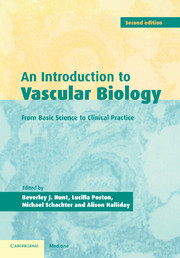Book contents
- Frontmatter
- Contents
- List of contributors
- Preface
- Part I Basic science
- Part II Pathophysiology: mechanisms and imaging
- Part III Clinical practice
- 12 Vascular biology of hypertension
- 13 Atherosclerosis
- 14 Abdominal aortic aneurysm
- 15 The vasculature in diabetes
- 16 The vasculitides
- 17 Pulmonary hypertension
- 18 Role of endothelial cells in transplant rejection
- 19 Vascular function in normal pregnancy and preeclampsia
- Index
16 - The vasculitides
Published online by Cambridge University Press: 07 September 2009
- Frontmatter
- Contents
- List of contributors
- Preface
- Part I Basic science
- Part II Pathophysiology: mechanisms and imaging
- Part III Clinical practice
- 12 Vascular biology of hypertension
- 13 Atherosclerosis
- 14 Abdominal aortic aneurysm
- 15 The vasculature in diabetes
- 16 The vasculitides
- 17 Pulmonary hypertension
- 18 Role of endothelial cells in transplant rejection
- 19 Vascular function in normal pregnancy and preeclampsia
- Index
Summary
Definition and introduction
Vasculitis is defined as blood vessel inflammation. The histopathological features are marked disruption of the normal vessel wall architecture, perivascular leukocyte infiltration and variable deposition of homogeneous fibrin-like material in the medial layer of the vessel wall (fibrinoid necrosis: Lie, 1990). The leukocyte infiltrate is frequently mixed, but may be predominantly neutrophilic, lymphocytic or eosinophilic. In some instances, specialized aggregates of macrophages and T cells (granulomata) are noted. Intravascular thrombosis and extravasation of blood frequently occur. Aneurysms can form through focal dilatation of the walls of muscular or elastic arteries and are at risk of rupturing. Intimal proliferation and/or fibrosis during healing can significantly narrow the vessel lumen (stenosis), leading to ischaemia or infarction. Arterial and venous vessels of any calibre, from the aorta to capillaries, can be affected. In many instances vasculitis is patchy but disseminated. Glomeruli are differentiated capillaries and, where small-vessel vasculitis involves the kidney, a segmental necrotizing glomerulonephritis (SNGN) is typically seen. The SNGN is also frequently ‘crescentic’, indicating the presence of inflammatory (mainly mononuclear) cells in Bowman's space surrounding the glomerular tuft. The vasculitides constitute a heterogeneous group of disorders affecting vessels of particular size and with distinct extravascular features. Pathological findings in different diseases frequently overlap.
Nonspecific early symptoms can delay diagnosis but evolving disease causes progressive organ damage which may become irreversible. Vasculitis must not be neglected in the differential diagnosis of any unexplained inflammatory response.
- Type
- Chapter
- Information
- An Introduction to Vascular BiologyFrom Basic Science to Clinical Practice, pp. 343 - 360Publisher: Cambridge University PressPrint publication year: 2002

